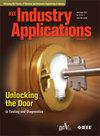具有协同调节资源的电-热集成微电网的频率约束调度
IF 4.2
2区 工程技术
Q2 ENGINEERING, ELECTRICAL & ELECTRONIC
引用次数: 0
摘要
鉴于电热一体化微电网(IEHM)内电网的低惯性特性,它很容易受到电力扰动引起的频率偏差的影响。为了在操作层面上应对这一挑战,本文提出了一种用于 IEHM 的频率受限调度方法。该方法可协调具有不同动态特性的协同资源,包括热电联产(CHP)机组、风力涡轮机和电池储能系统(BESS),以促进一次频率调节(PFR)。通过考虑协同 PFR 资源的约束条件来维持动态和静态频率安全。我们采用分布稳健(DR)联合机会约束来管理风能渗透率较高的 IEHM 中的风电不确定性。基于上述建模,我们为 IEHMs 开发了一个频率约束调度模型。该模型整合了耦合能源部门,在保证频率安全和 IEHM 日成本最小化的同时,平衡了 PFR 储备和能源供应。为了解决非凸 DR 联合机会约束,我们采用了一种基于 Wasserstein-metric模糊集的 big-M-free 重拟方法,该方法需要的预定义参数更少,计算效率显著提高。最后,对两个测试系统进行的大量案例研究验证了所提方法的有效性和可扩展性。仿真结果还强调了热负荷对 IEHM 中 PFR 的影响。本文章由计算机程序翻译,如有差异,请以英文原文为准。
Frequency-Constrained Dispatching for an Integrated Electricity-Heat Microgrid With Synergic Regulation Resources
Given the low-inertia nature of the power grid within the integrated electricity-heat microgrid (IEHM), it is vulnerable to frequency deviations caused by power disturbance. To address this challenge at the operational level, this paper proposes a frequency-constrained dispatching method for IEHMs. This method coordinates synergic resources with diverse dynamic features, including combined heat and power (CHP) unit, wind turbine, and battery energy storage system (BESS), to contribute to primary frequency regulation (PFR). Frequency security, both dynamic and static, is maintained through constraints that account for synergic PFR resources. We employ a distributionally robust (DR) joint chance constraint to manage the wind power uncertainty in IEHMs with a high penetration of wind energy. Based on the above modeling, we develop a frequency-constrained dispatching model for IEHMs. This model integrates the coupled energy sectors to balance the PFR reserves and energy supply while guaranteeing frequency security and minimizing the daily cost of IEHM. To tackle the nonconvex DR joint chance constraint, we adopt a big-M-free reformulation approach based on the Wasserstein-metric ambiguity set, which requires fewer predefined parameters and significantly enhances computational efficiency. Finally, extensive case studies on two test systems validate the effectiveness and scalability of the proposed method. Simulation results also highlight the impact of heat load on PFR in IEHMs.
求助全文
通过发布文献求助,成功后即可免费获取论文全文。
去求助
来源期刊

IEEE Transactions on Industry Applications
工程技术-工程:电子与电气
CiteScore
9.90
自引率
9.10%
发文量
747
审稿时长
3.3 months
期刊介绍:
The scope of the IEEE Transactions on Industry Applications includes all scope items of the IEEE Industry Applications Society, that is, the advancement of the theory and practice of electrical and electronic engineering in the development, design, manufacture, and application of electrical systems, apparatus, devices, and controls to the processes and equipment of industry and commerce; the promotion of safe, reliable, and economic installations; industry leadership in energy conservation and environmental, health, and safety issues; the creation of voluntary engineering standards and recommended practices; and the professional development of its membership.
 求助内容:
求助内容: 应助结果提醒方式:
应助结果提醒方式:


